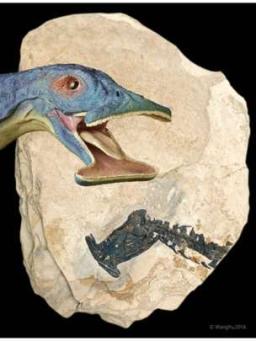A crocodile-sized creature that lived 242 million years ago was the first known vegetarian marine reptile, according to new fossil evidence.
Two specimens unearthed in China reveal details of the animal's skull and how it fed.
Named Atopodentatus, scientists say its hammer-shaped skull helped it to feed on underwater plants.
Only a handful of marine reptiles, living or extinct, are known to be herbivores.
Dr Nick Fraser of National Museums Scotland, who worked on the fossil, said it belongs in the pages of a children's storybook by Dr Seuss, which depicts animals with a strange jumble of features.
The reptile was "a bizarre, bizarre animal", he explained.
"We envisage it scraping algae and the like off rocks underwater.
"Herbivorous marine reptiles are very rare - this is the oldest record that we know of."
Strangely toothed
The first fossils of the creature were discovered a few years ago.
It was named Atopodentatus unicus , which is Latin for "unique strangely toothed".
New fossils unearthed in China's Yunnan Province by Chun Li of the Institute of Vertebrate Paleontology and Paleoanthropology in Beijing give a detailed picture of the animal's skull.
The discoveries, unveiled in the journal, Science Advances , show that rather than having a zipper-like snout as previously thought, the animal had a wide hammer-headed jaw filled with peg-like front teeth.
Play-Doh

 Scientists used clay to make a model of the jaw to work out how the animal fed.
Scientists used clay to make a model of the jaw to work out how the animal fed.
"To figure out how the jaw fit together and how the animal actually fed, we bought some children's clay, kind of like Play-Doh, and rebuilt it with toothpicks to represent the teeth," said co-researcher Olivier Rieppel of the Field Museum in Chicago.
"We looked at how the upper and lower jaw locked together, and that's how we proceeded and described it."
He said Atopodentatus also helps tell a bigger story about the world's largest mass extinction 252 million years ago.
It lived at a time when the Earth was recovering from the loss of 90% of all marine mammals.
"The existence of specialised animals like Atopodentatus unicus shows us that life recovered and diversified more quickly than previously thought," he said.
"And it's definitely a reptile that no one would have thought to exist - look at it, it's crazy!
http://www.bbc.com/news/science-environment-36195167

It seems that the more we learn, we find that there is still so much left to be learned.
It was a big step during my school years that when studying a subject I came to the realization of how little I knew and comprehended that there was so much more that I didn't know. Those who think they "know it all" are the ones who really know nothing.
It's the years that astonish me. I mean this creature lived 242 million years ago! It is difficult to wrap one's mind around just how long ago that was, especially considering how relatively brief of a time humans have existed. And this was an animal that was part of a recovery of a mass die off that had occurred 10 million years before that!
Each new discovery leads to another set of questions. This is great stuff.
I am more amazed every time I read an article like this one and humbled by how much there is still left to learn. When the internet was first getting going (or at least when I first got online in 1995) I would just put a word or subject in a search engine and could spend hours going from link to link to link. When I was a kid and bored I would grab a volume of an encyclopedia at random off from the shelf and just start reading where it opened.